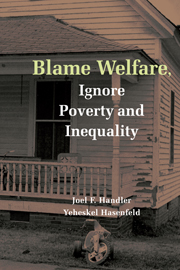Book contents
- Frontmatter
- Contents
- Acknowledgments
- List of Acronyms
- 1 Introduction
- 2 The State of Poverty: TANF Recipients
- 3 The Response to Poverty and Inequality: The Welfare State
- 4 Demonizing the Single-Mother Family: The Path to Welfare Reform
- 5 The Welfare Bureaucracy
- 6 Work and the Low-Wage Labor Market: Mothers and Children
- 7 Welfare Reform and Moral Entrepreneurship: Promoting Marriage and Responsible Parenthood and Preventing Teenage Pregnancy
- 8 Addressing Poverty and Inequality
- References
- Author Index
- Subject Index
7 - Welfare Reform and Moral Entrepreneurship: Promoting Marriage and Responsible Parenthood and Preventing Teenage Pregnancy
Published online by Cambridge University Press: 20 August 2009
- Frontmatter
- Contents
- Acknowledgments
- List of Acronyms
- 1 Introduction
- 2 The State of Poverty: TANF Recipients
- 3 The Response to Poverty and Inequality: The Welfare State
- 4 Demonizing the Single-Mother Family: The Path to Welfare Reform
- 5 The Welfare Bureaucracy
- 6 Work and the Low-Wage Labor Market: Mothers and Children
- 7 Welfare Reform and Moral Entrepreneurship: Promoting Marriage and Responsible Parenthood and Preventing Teenage Pregnancy
- 8 Addressing Poverty and Inequality
- References
- Author Index
- Subject Index
Summary
For most Americans, welfare reform meant “ending welfare as we know it” – abolishing Aid to Families with Dependent Children (AFDC), dramatically increasing the work requirements and sanctions, and imposing time limits. Welfare was no longer going to be “a way of life.” Perhaps less noticed, but a central feature of the reform agenda, were “family values.” In fact, three out of the four purposes of the new legislation dealt with “family values.” In addition to the first goal of providing assistance to needy families, the goals of Personal Responsibility and Work Opportunity Reconciliation Act (PRWORA) are to “(2) end the dependence of needy parents on government benefits by promoting job preparation, work, and marriage; (3) prevent and reduce the incidence of out-of-wedlock pregnancies and establish annual numerical goals for preventing and reducing the incidence of these pregnancies; (4) encourage the formation and maintenance of two-parent families.” The legislation stated a series of findings to justify these goals. Among them are the following:
Marriage is the foundation of a successful society.
Marriage is an essential institution of a successful society that promotes the interests of children.
The increase in the number of children receiving public assistance is closely related to the increase in births to unmarried women.
The increase of out-of-wedlock pregnancies and births is well documented.
An effective strategy to combat teenage pregnancy must address the issue of male responsibility, including statutory rape culpability and prevention.
The negative consequences of an out-of-wedlock birth on the mother, the child, the family, and society are well documented.
- Type
- Chapter
- Information
- Blame Welfare, Ignore Poverty and Inequality , pp. 282 - 315Publisher: Cambridge University PressPrint publication year: 2006

